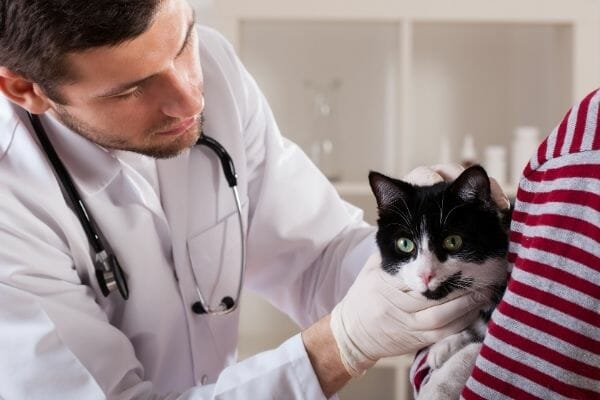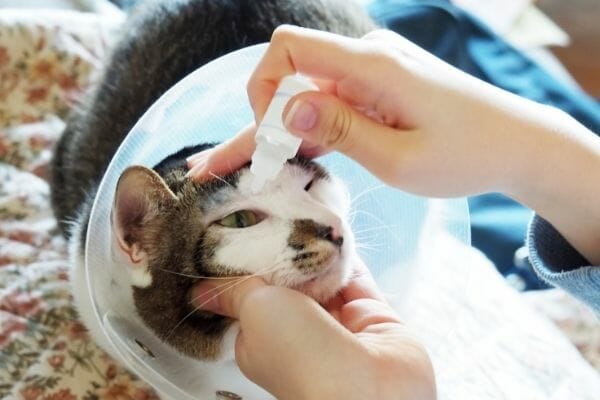Cats have beautiful, haunting eyes that allow them to clearly see in the dark. But when your cat’s eyes appear red, swollen, or something gooey is keeping them shut, there is definitely something wrong. More importantly, something must be done to help your cat because the eye problem may lead to irreparable consequences.
As a reminder: This post aims to educate pet owners on the possible causes of cat eye infections, but it is not meant to replace a much-needed visit to the veterinarian. As a responsible cat parent, you should always consult with your vet before doing anything to treat your cat.
If you’re not sure whether your cat’s eyes are irritated, this article discusses:
- Signs your cat has an eye infection
- Possible causes of your cat’s eye infection
- Dos and don’ts of cat eye cleaning
- How to prevent future cat eye infections
Signs of a Cat Eye Infection
No matter how hard you try to keep your cat clean and healthy, she may get an eye-related illness one way or another. PetHelpful lists the common signs of a cat eye infection:
- Clear, green, yellow, or brown eye discharge
- Clear, green, yellow, or brown nasal discharge
- Crusting or pus collected near the tear ducts
- Dry eyes or excessive tear drop production
- Eye eruption and herpes-like lesions
- Fever
- Inflammation of the eye or the third eyelid
- Lethargy, inappetence, and weight loss
- Red mucous membranes
- Rubbing, itching, winking, and squinting
- Sneezing
Aside from these aforementioned symptoms, your cat may also be blinking a lot and pawing her eyes against objects such as your furniture, rug, and carpet.

Possible Causes of Your Cat’s Eye Infection
There are many reasons why your cat has picked up an eye infection. It can be something as simple as foreign objects irritating her eye to something more serious such as bacteria or virus infecting her body. Some common illnesses related to cat eye infections include:
- Conjunctivitis – Also known as pink eye, this is an inflammation of the light pink lining around your cat’s eye. It is caused by viruses or bacteria.
- Corneal ulcer – Also called ulcerative keratitis, this painful condition happens when the deepest layers of your cat’s cornea are damaged or lost. Cats with scratches to the cornea are prone to developing eye problems from viruses and bacteria.
- External objects – Splints, grass seeds, dust particles, and mold are just some examples of irritants that can cause your cat to rub her eyes.
- Feline Upper Respiratory Infection (URI) – This contamination is caused by viruses such as feline calicivirus, pneumonitis or rhinotracheitis (herpesvirus), bacteria, and protozoa.
- Uveitis – An inflammation of the internal structures of your cat’s eyes, uveitis may be caused by cancer, immune problems, infections, or trauma.
Other factors/diseases such as allergens, autoimmune disease, cancer, cherry eye, injury, systemic viral infections, or feline immunodeficiency virus may also cause cat eye problems. It is also possible for cats experiencing stress or ones who have been exposed to infected cats to get eye illnesses. For healthy cats living in stable environments, an unexpected eye infection may indicate a more serious, underlying disease at play.

Dos and Don’ts of Cat Eye Cleaning
Though it may be tempting to go online and research home remedies that you could make to treat your cat’s swollen eyes, doing so might cause permanent damage to her vision. Worse, the wrong ingredients (apple cider vinegar, colloidal silver, and manuka honey, to name a few) might make her lose her eyesight completely. As such, it is highly recommended that you schedule an appointment with your vet if you notice your cat’s eye problem manifesting for more than 24 hours. Similarly, talk to your vet if you notice your cat squinting or having difficulty seeing. Do not use medicine from your cat’s previous eye problem or over-the-counter eye drops and washes until the vet has checked your cat.
Once the vet has diagnosed your cat and given you instructions on how to properly attend to her, help keep your cat’s eyes as clean as possible. Remove the gunk from her eyes by following this step-by-step guide:
- Wash your hands thoroughly.
- Wrap your cat in a blanket or towel to keep her head supported and her body secure.
- Wet a few pieces of cotton balls in lukewarm distilled water. Do not use tap water.
- Squeeze out excess water from the cotton ball.
- Place the cotton ball over her eye without pressing or applying pressure.
- Gently wipe the cotton ball following the direction of your cat’s fur, from the tear duct to the outer eye.
- Use a fresh cotton ball for each eye to avoid spreading infection.
- When applying vet-approved medication, start with your cat’s good eye before applying medicine on the infected eye.
- Repeat the process as needed.

How to Prevent Future Cat Eye Infections
Avoid eye problems from developing by regularly checking your cat’s eyes for a change in colour or shape, cloudiness, discharge, redness, or sensitivity to light. Assist your cat by gently removing the discharge in her eyes and brushing her fur regularly. Feed her with nutrient-rich meals and snacks (check our list of cat-friendly human food!) and keep her environment stress-free. Vaccinate young cats and keep up with yearly vaccinations to prevent infection. It is also advisable to avoid kitty overcrowding, since they are more prone to getting bacteria and viruses from other infected cats.
Read up on other cat-related guides on our blog. From making your backyard pet-friendly to preventing your cat from sleeping in your bed, we’ve got all the resources you need to be the purr-fect parent!
Leave a comment
Your email address will not be published. All fields are required.